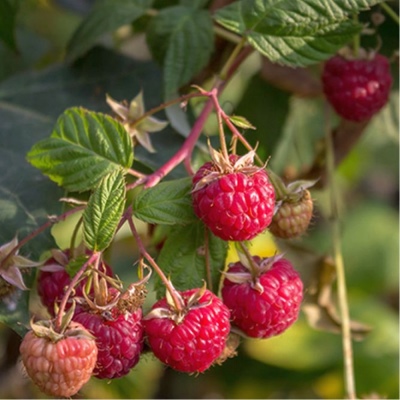
- Authors: NIISS named after M.A. Lisavenko, V.I. Anisova, I.P. Kalinina, A.D. Zabelina
- Repairability: No
- Berry color: red
- Taste: sweet and sour
- Ripening period: average
- Berry weight, g: 2,3-4,5
- Yield: average 5.8, maximum - 7.0 t / ha
- Frost resistance: winter hardy, up to -35 С
- Drop off location: flat area with a slight slope, well-drained, sheltered from the wind
- Fruiting period: mid to late July
The harsh climatic conditions of our country often complicate the task for gardeners. So, raspberry breeders are in constant search of a variety that can withstand severe frosts, while being distinguished by high productivity and good taste. The frost-resistant and large-fruited Altai Zorenka deserves their special attention.
Description of the variety
The tall and medium spreading variety Zorenka Altai was bred at the N.I. Mikhail Afanasyevich Lisavenko for cultivation in risky farming zones by hybridization of wild-growing forest raspberries and the Vityaz variety. It is characterized by long, light brown shoots and large, grayish green and slightly wrinkled leaves.
Among the advantages should be highlighted:
high productivity;
large-fruited;
great taste;
high frost resistance;
transportability.
There are also disadvantages:
the presence of a few soft spines;
susceptibility to purple spot and raspberry beetle.
Ripening terms
The variety is mid-season - the ripening of berries is observed in the last decade of July.
Yield
Zorenka Altai boasts a bountiful harvest - up to 7.0 t / ha.
Berries and their taste
The berries are large (weight can reach 4.5 g), red, blunt-conical in shape, with strong adhesion of the drupes. The fruits will delight the sweet tooth with juicy pulp and pleasant aroma, rich dessert taste with sourness and the ability to make compotes, jams and other preparations for the winter from them.

Growing features
The rules for planting and growing Altai Zorenka as a whole differ little from the generally accepted ones. Nevertheless, in order to obtain a high yield, it is necessary to take into account some of the characteristics of this variety.
Site selection and soil preparation
The variety prefers brightly lit areas with deep groundwater and fertile, neutral or slightly acidic soil. Raspberries also need protection from cold winds, so bushes should be planted near a fence or outbuildings.
It takes root well in the place of legumes, green manure plants and cereals. In place of berry bushes, on the contrary, it grows poorly and often gets sick. For planting, pits or trenches up to 30 cm deep should be prepared. Otherwise, the algorithm of actions is no different from the rules for planting other varieties.
Note! When landing, it is important to observe the following distances:
for the belt method - 1 m between bushes, 2 m between rows;
for trenching - 0.4 m between plants, 1 m between rows.


Pruning
Pruning must be done 2 times a year. Before the wintering of the shrub, the fertile and diseased shoots are removed, and in the spring the frozen stems are cut off, leaving only a dozen of the strongest. The procedure helps to maximize yields and reduces the risk of developing diseases.

Watering and feeding
Moderate watering is required - to obtain a rich harvest, a dozen waterings per season are enough. In no case should the soil be waterlogged, this can lead to decay of the rhizomes.
In order to improve the quality of berries, special attention should be paid to feeding:
in the spring, nitrogen fertilizers are needed, including nitrate and urea;
before setting the fruit, complex mineral fertilizing is needed;
after harvesting, potash-phosphorus compositions are introduced;
in preparation for winter, the bush is fed with phosphorus-containing fertilizers.


Frost resistance and preparation for winter
The variety is distinguished by high frost resistance (up to -35 ° C), but in the fall you still have to take care of bending the shoots to the ground - so the bush will be reliably protected under a layer of snow in winter. If this is neglected, exposed stems can freeze.
Note! It is advisable to remove and destroy two-year-old shoots in order to reduce the risk of fungal diseases.

Diseases and pests
The variety is highly resistant to most diseases and insect attacks. However, in order to avoid unpleasant surprises, it is necessary to strictly follow the rules of irrigation and feeding, not forgetting about prevention. Periodically, it is worthwhile to carry out a visual inspection of the plant - this will allow timely identification and elimination of most of the problems.
Early spring treatment with copper-containing "Abiga-Peak" and "Oxykhom" will protect against purple spotting, and "Fitoverm" and "Fufanon" will help against the raspberry beetle.
Note! If affected shoots are found, they should be immediately cut and burned.

Unfortunately, raspberries, like other plants, do not bypass various diseases and pests. Only armed with the knowledge and the necessary means for this, you can cope with such troubles.To help the plant, it is very important to be able to recognize the disease in time and begin timely treatment.
Reproduction
Reproduction is carried out by root suckers or cuttings. In the spring, the shoots should be separated from the mother bush along with a lump of soil and planted in pre-prepared holes 30 cm deep. After planting, you will need to apply fertilizer, water abundantly and mulch the soil around the seedling.
It is necessary to prepare for propagation by cuttings in advance, and in the spring, separate large cuttings from the bush, cutting them into twigs 20 cm long.The latter are planted in containers with fertile soil and placed in a greenhouse before the autumn transplantation to a permanent place.








































































